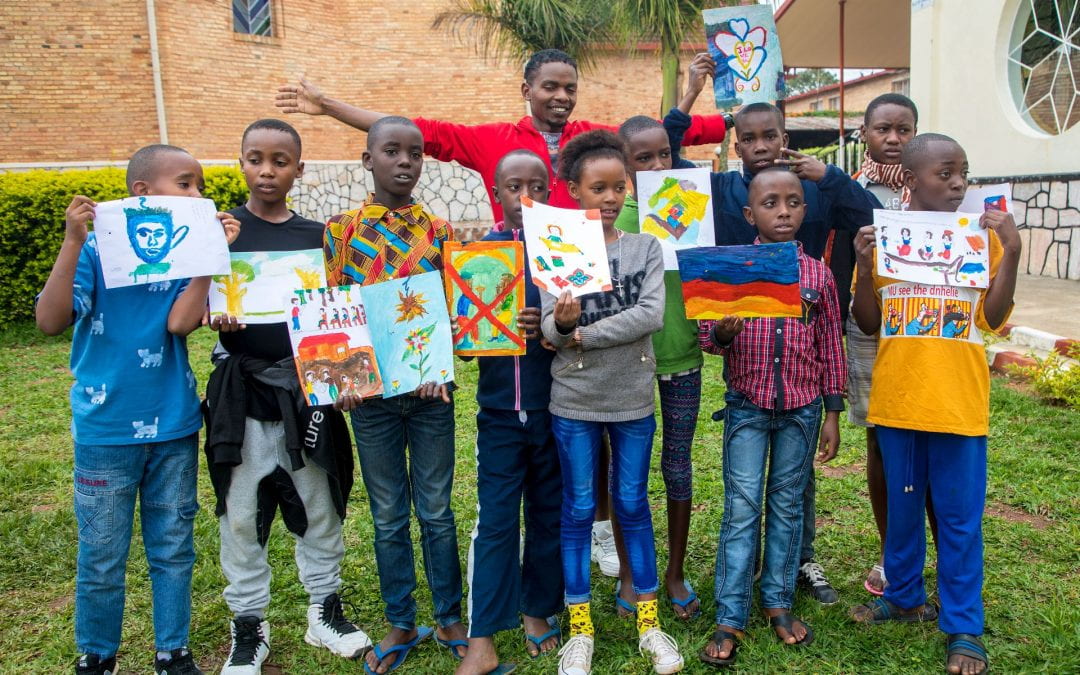
Nov 22, 2020 | Blog, Events, Resources
Written by: Danae Chatzinikoli and Stefania Vindrola.
Mobile Arts for Peace (MAP) and Changing the Story (CTS) hosted a three-day conference from 5 – 7 August in collaboration with the Institute of Research and Dialogue for Peace (IRDP) in Rwanda. The conference focused on encouraging child and youth participation through arts-based methods to inform policy and decision-making. It was an opportunity for MAP facilitators, master trainers, policymakers, organisations, partners and participants from Rwanda, Indonesia, Kyrgyzstan, Nepal, the United Kingdom and other countries, to interact through both physical and online spaces.
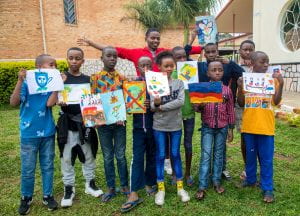
While attending, the concept of ‘participation’ took many different forms. As in most conferences, one could participate by observing, actively participating or both. But due to the new reality that Covid-19 has imposed, alternative ways of participating were introduced. This conference had people participating by being in the conference rooms practicing social distancing, but it also had most of its participants, actively participating from their spaces all around the world online. Time-zones, connectivity and distances were merged into this event. Talks were delivered online from many different places and discussions were made between people who were on opposite sides of the planet. That surely changes the concept of participation and respects the ‘right to participate’ in a different manner. Under normal circumstances, the right to participate would be respected by allowing anyone relevant wishing to participate. Having a specific location for the event would exclude anyone who was not geographically available; therefore, keeping the event limited to people already at the location or those able to travel there. Of course, that creates other types of inequalities in terms of connectivity. Not everyone has access to the internet, and not everyone has a device they can use at any time. But what worked really well for this specific event is that it was hybrid, by having participants both online and in person. It allowed anyone from anywhere to participate eliminating any spatial difficulties that would otherwise limit them. Equally, it allowed young people in Rwanda – who would potentially have had connectivity issues due to a low internet access – to be involved directly. Therefore, the MAP-CTS event was able to equally promote the ‘right to participation’ going beyond social differences that might affect it.
Despite social distancing measures and restrictions, the conference allowed young people to voice their opinions and suggestions in relation to social issues in Rwandan society. It offered them a space to be, act and feel as citizens and exercise their right to participate and be heard. This is remarkable because young people are often perceived as ‘not-yet-adults’: individuals who have not yet developed the competency, rationality and maturity of adults (Uprichard, 2008). As a result, their ideas and opinions do not receive the attention they deserve. The MAP – CTS conference was structured in a way that promoted youth participation throughout the three days. Every session included moments for young people to express their thoughts and answer questions from policymakers and other attendees. Furthermore, their feelings and ideas – represented in a theatre presentation they performed – were the starting point for further group discussions. Throughout the event, young people were involved as much (if not even more) as adult participants. This reflects that, within the MAP-CTS Project, the right to participate is not ‘given’ to young people but otherwise is constructed on the basis of horizontal relations with adults. According to Lundy (2007), children’s right to participate should be guaranteed in a safe and inclusive space, and with adults that listen (not just hear) actively to their voices. This was clear during the MAP-CTS conference not only because of the high youth participation rate, but also because of the inclusion of a diverse range of participants from different ages, gender and school levels. Moreover, the right to participate was not an imposition from adults; during the group discussions young people were always asked if they would be willing to express their opinion as a way to show them it was entirely their decision and that it was safe to do it.
The MAP – CTS Project encourages children and young people to realise that they can and have the right to participate in broader society. This will motivate them to raise their voices with more impetus and strength, but will also have a significant impact on the way they are conceptualised by other generations. The Project goes beyond common stereotypes that tend to consider young people as irresponsible individuals who always get in trouble and cannot control their actions and emotions (Brown, 2009). It contributes to changing the image we have about them and positions them as valuable contributors and shapers of society. For example, one of the aims of the MAP – CTS Project is to connect young people with policy-makers through art-based methods. By doing that, the ‘right to participate’ is again respected in multiple ways. Firstly, young people have the opportunity to participate in a project that allows them to practice their right. Within the project and its workshops, the young people are trained and then train other people in the arts-based methodology. The methodology acts as a tool to reach the next step of the project which is the promotion of peace-building and constructive change. Through the process of being trained and then potentially training others, young people claim their right to participate. There is not some authority that allows them to do so, the training and learning is the enabler in the specific context.
MAP – CTS Project bridges childhood and youth with the policy-making arena. This is an interesting connection because, in the public discourse, political debates and policy-making are activities usually restricted to adults. The Project opens new possibilities for young people and extends their right to participate from their inner realities (family and school) towards their local contexts more broadly. Young people’s views are the pillar of the Project, the reason that connects adults, teachers and policy-makers, and enables them to construct relations with the aim of fostering social changes. In this sense, MAP-CTS promotes a ‘right to participation’ that goes beyond a tokenistic approach and takes young people’s views seriously (Lundy, 2018). Additionally, the Project allows children and young people to understand how policy-making works, how policy documents are created and enacted by different social actors. Therefore, apart from its goal of connecting young people and policy-makers through arts-based methods, MAP – CTS is also a way for the former to learn how society functions every day.
Through this short analysis, it becomes clear that the MAP-CTS Project contributes to rethinking young people’s ‘right to participation’. It does so both by its structure and practically. This specific event can be thought of as a paradigm of how this Project respects children’s and young people’s ‘right to participate’ and of how the response to Covid-19 can create new paths to thinking about participation.
References
Brown, K. (2009). Children as Problems, Problems of Children. In Qvortrup, J., Corsaro, W. & Honig, M-S. (Eds.), The Palgrave Handbook of Childhood Studies (pp. 256 – 272). London: Palgrave MacMillan.
Lundy, L. (2007). ‘Voice’ is not enough: conceptualising Article 12 of the United Nations Convention on the Rights of the Child. British Educational Research Journal, 33(6), 927 – 942.
Lundy, L. (2018). In defence of ‘tokenism’? Implementing children’s right to participate in collective decision-making. Childhood, 25(3), 340 – 354.
Uprichard, E. (2008). Children as ‘Being and Becomings’: Children, Childhood, Temporality. Children & Society, 22, 303 – 313.
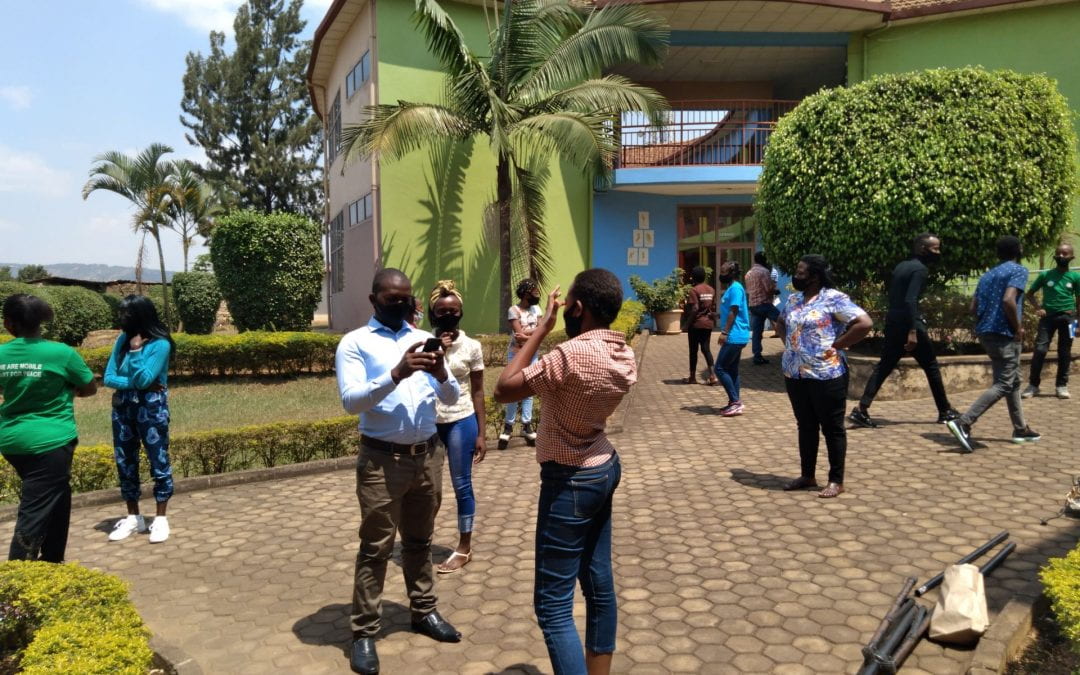
Nov 22, 2020 | Blog, Events, Resources
Written by Di Wu
A 3-day event was hosted by the Mobile Arts for Peace (MAP) and Changing the Story (CTS), in collaboration with the Institute of Research and Dialogue for Peace (IRDP) in Rwanda. The event aimed at using art-based approaches to engage young people, educators, cultural artists and policy makers to influence curriculum and policy-making for peacebuilding. The event provided a rich and dynamic platform that enabled participants from Rwanda, Kyrgyzstan, Indonesia, Nepal, Cambodia, Ugand, and other countries to actively build conversation, share ideas and find solutions by addressing the young people’s theatre play, story-telling and other art-based activities despite the time and geographical differences across the countries as well as the limited conditions caused by Covid-19.
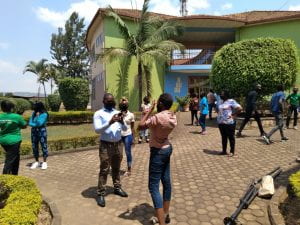
As the founder of MAP Professor Ananda Breed said, “in terms of the projects, there is building of art skills, creative thinking, well being and a space or environment in which young people feel abled to share stories in a deep and meaning ways and apply their stories to influence others, to find solutions to those problems in their community.” In other words, the project enables young people to voice their views and assert their agency through creative and expressive means. In the study of childhood, children and young people are recognized as ‘voiceless’ due to the lack of power and their minor position in relation to adults. It is true that children and young people are restrained by the limited platforms to express their voices. Even though they increasingly participate in different programs, organizations and governments due to the promotion of children’s rights, there is still a gap between practice and policy and the programs are often “tokenistic, unrepresentative in membership, adult-led in process, and ineffective in acting upon what children want”. [1]
Portraying children and young people as ‘voiceless’ tends to neglect the fact that they are able to utilize art tools, such as theatre play, story telling and music to expressing their agency in creative, articulate and meaningful ways and therefore to negotiate their position in adult-dominant world and actively engage in the political arenas. [2] Through a series of activities including a curriculum workshop, training of trainers and drama clubs organized by MAP, children and young people are expected to be at the centre, voicing their everyday lives in the complex social and cultural contexts through bodily actions, theatre and musical performance and other creative methods in order to build dialogue, influence and challenge their relationships with parents, communities and wider social structures. MAP Rwanda youth trainer Sandrine said that there was a big difference between before and after engaging with MAP. Before being part of MAP, she was a very fearful person who could not stand in front of people. After engaging with MAP, she feels free and can stand in front of people and express her ideas clearly.
The MAP methodology also ensures that the adult educators are able to better understand their students from a new perspective and therefore develop and improve the curriculum and learning environment accordingly. A MAP research participant from Rwanda stated that he used MAP activities including drama plays to prepare lesson plans and learners were more motivated and interested. Those activities enable young people to find ways to solve their own problems that are there in society; to clarify the root causes, the consequences, and to find solutions. It is through that platform that the school principals know the problems students have and they try to search for the solutions together.
So far, MAP has reached 250 educators and 2,000 young people in Rwanda and more educators, youth facilitators and students in Kyrgyzstan, Indonesia and Nepal. The MAP approach provides creative means for young people to express concerns and ideas through multiple methods t and to be heard, which therefore builds dialogue among young people, trainers, communities and policy makers to identify and find solutions for peacebuilding.
****
[1] Taft, J. K. (2015). “Adults talk too much”: Intergenerational dialogue and power in the Peruvian movement of working children. Childhood, 22(4), 460-473.
[2] Emberly, A., & Davhula, L. A. (2016). My music, my voice: Musicality, culture and childhood in Vhavenda communities. Childhood, 23(3), 438-45

Aug 27, 2020 | Blog, Related Activities & Initiatives, Resources
Written by Professor Ananda Breed
Mobile Arts for Peace (MAP) and Changing the Story (CTS) hosted a three-day conference that focused on ‘Arts-based Research for Education and Peacebuilding’ from 5 – 7 August with the Institute of Research and Dialogue for Peace (IRDP) as a co-host in Rwanda.[1]
Speakers included the MAP youth facilitators and master trainers alongside the University of Rwanda, the National Unity and Reconciliation Commission (NURC), Never Again Rwanda, Aegis Trust, Rwanda Education Board (REB) and UNESCO as well as workshops, performances and panels. The conference used technology to link partners across Rwanda, Kyrgyzstan, Indonesia, Nepal, Cambodia, Uganda, the United Kingdom and other countries. Zoom, live camera feed, and combined physical and virtual break out rooms enabled connection and interaction between the 40 participants who were located at IRDP and between 40-50 participants who joined online across the three-day event. [2]
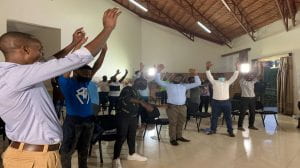
MAP Master Trainers and Youth Facilitators
Due to travel restrictions and social distancing measures during the time of COVID, the event highlighted the opportunities and possibilities for digital technology to connect research communities on a global level. This focus built upon an online webinar by Changing the Story, ‘From Grassroots Participation to Policy’, which examined new possibilities for grassroots engagement with policymakers.
Beyond the attendees at IRDP and online, there were additional communication hubs set up for MAP participants to engage with the event in each of the five provinces (Northern Province, Southern Province, Eastern Province, Western Province and Kigali Province). Laptops and communication packages were administered for MAP research participants to follow the event through communication hubs (for those who did not own their own computer or smart phone). In this way, MAP created a responsive, creative, and innovative digital platform that used a blended approach between online and physical spaces to engage with our research participants across Rwanda and other countries.
The Principal Investigator of CTS, Professor Paul Cooke, stated: ‘The event was a Master Class in how to turn a necessity into an opportunity. It was great to have such international interaction. While I would have much preferred to be in the room in person in Rwanda, we could never have afforded to bring such an international group together.’
An online participant in Rwanda stated: ‘The event was well organised. I appreciated the discussions in groups and the presentations about the problems in society using the solution tree exercise. Thank you for inviting different partners in education, especially the Rwanda Education Board (REB), which is the one to elaborate education policies. Thank you for providing us with all of the necessary materials needed to follow the event. We were connected and allowed each and everything.’
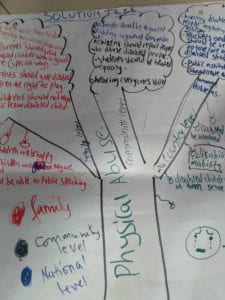
A MAP Exercise, called the ‘Solutions Tree’, completed by event participants
One of the primary outcomes of the event was the successful generation and distribution of knowledge on a local level (communication hubs across Rwanda) and on a global level (linking the event to participants and partners in Kyrgyzstan, Indonesia, Nepal, Cambodia, Uganda, the United Kingdom and other countries). In this way, MAP discovered new opportunities provided by communication and digital technology to provide additional opportunities to engage our research participants and to have greater impact on local and international levels. During the conference, MAP youth facilitators and master trainers worked alongside the participants at IRDP and the online community to explore the root causes of conflict and their solutions in response to the staged issue of discrimination (that was illustrated through a video clip of a forum theatre performance about disability that was originally generated through the sharing of personal stories during a MAP youth camp held November 2019).
Another online conference attendee and MAP research participant stated: ‘MAP activities help especially in the teaching and learning process and education in general. For example, when I am teaching, I use these activities to prepare a lesson plan; and because they are engaging, learners are motivated and interested. MAP activities match with competence-based curriculum which is currently used in Rwanda. MAP activities made the youth improve their way to solve their own problems that are there in society; to clarify the root causes (and any other causes), the consequences, and to find solutions. At my school, we have MAP clubs that perform plays in front of the school. It is through that platform that the school principals know the problems students have and they try to search for the solutions together.’

MAP activities and discussion groups
Following discussions that linked the physical and online break out rooms, a solution tree exercise elicited feedback in relation to the perceived conflict, root causes, consequences and solutions. In terms of informing policy, a representative from the REB and UNICEF responded very positively to the solution tree and a draft policy brief was presented by the MAP youth facilitators and master trainers.
Ministers from government institutions sent WhatsApp chats to the director of IRDP and CTS Co-I, Eric Ndushabandi, in response to the policy brief. In this way, MAP served to communicate the issues that young people face through arts-based methods (performance, visual arts, film) to policy makers; in this way establishing a two-way form of communication between young people and policy makers. We aim to harness these approaches and findings within the development of an AHRC GCRF Network Plus project entitled Mobile Arts for Peace: Informing the National Curriculum and Youth Policy for Peacebuilding in Kyrgyzstan, Rwanda, Indonesia and Nepal (2020-2024).
For more information about MAP, please go to the website: map.blogs.lincoln.ac.uk or contact Ananda Breed at ABreed@lincoln.ac.uk.
****
[1] MAP was a Phase One project for Changing the Story (2017-2021) led by Co-I Ananda Breed and Eric Ndushabandi that evolved into a fully-fledged Network Plus project led by Ananda Breed as Principal Investigator and eight Co-Investigators from Kyrgyzstan, Rwanda, Indonesia, Nepal and the United Kingdom (Tajyka Shabdanova, Eric Ndushabandi, Sylvestre Nzahabwanayo, Harla Sara Octarra, Bishnu Khatri, Rajib Timalsina, Kirrily Pells, Koula Charitonos and Fereshte Goshtasbpour).
[2] Registrants included 42 participants on 5 August, 52 participants on 6 August and 43 participants on 7 August.
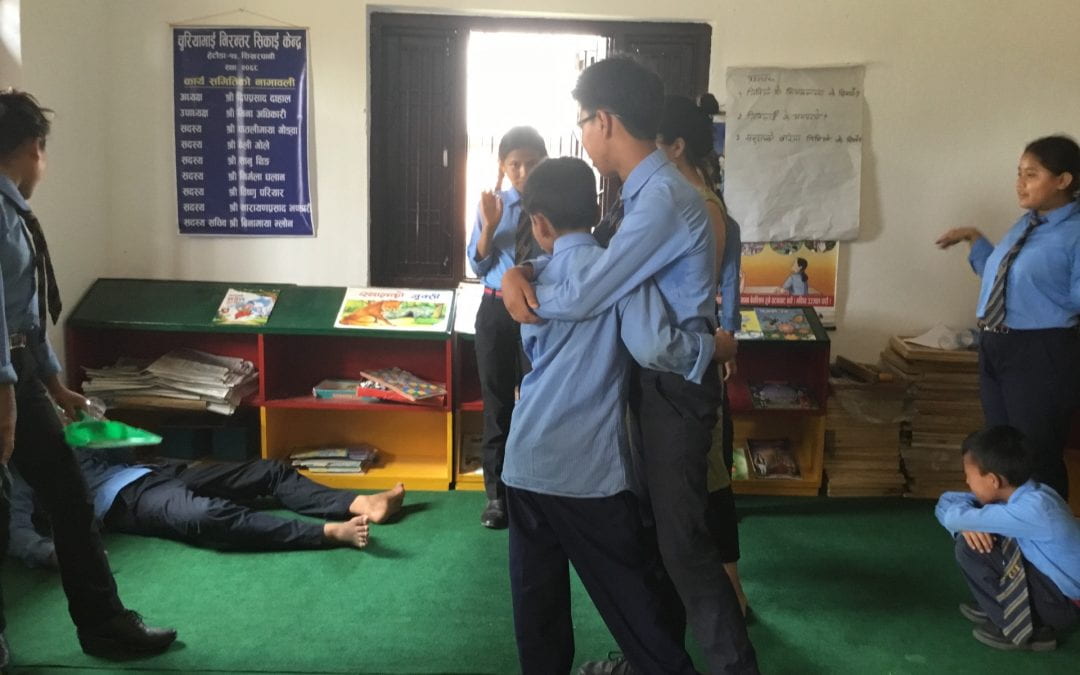
Mar 23, 2020 | Blog, MAP archive, Peace Education, Related Activities & Initiatives, Toolkits for Youth
This post was originally published via Changing the Story (CTS)’s #YoungChangemakers series on 1st October 2019, as part of the CTS sub-project Examining the Interpretations of Civic National Values Made by Young People in Kenya and Nepal.
Changing the Story is an AHRC GCRF project which asks how the arts, heritage and human rights education can support youth-centred approach to civil society building in post-conflict settings across the world. The ‘Examining the Interpretations of Civic National Values Made by Young People in Kenya and Nepal’ was closely linked to the methodologies used in the CTS MAP project, and contributed to Nepal becoming one of MAP’s current country focus. Find out more about Changing the Story and see the original post here: https://changingthestory.leeds.ac.uk
‘Examining Interpretations of Civic National Values made by Young People in Kenya and Nepal’ is led by a consortium of UK, Kenyan and Nepalese partners, a fusion of academics, educators, peacebuilders, civil society organisations and Performance Arts Companies that focus on Theatre.
Our project fuses performance arts methodologies as a pedagogical approach to teaching and learning in primary schools. We provide children with the opportunity to reflect on what they may know of past conflict in their countries, but through their understanding of community peacebuilding in the now, and for the future. This project is centred fully as a comparison of young voices from Kenya and Nepal. However, it is a project that speaks comparatively to the statutory teaching and learning of ‘civic national values’ in UK early years settings, primary and secondary schools through the notion of ‘Fundamental British Values’. These have emerged from more recent and current times of social and religious conflict and are stated as: democracy; the rule of law; individual liberty; mutual respect for and tolerance of those with different faiths and beliefs and for those without faith. The statutory teaching of these is aimed at preventing radicalisation in young people and seeks to foster a universal sense of connection and belonging to national identity.
Our decision to develop a comparison of educational responses to teaching and learning about civic national values in Kenya and Nepal was associated with commonalities to the UK context, but more specifically to congruency identified in Kenyan and Nepalese policies for post-conflict citizenship education. This is identified by the discourses of ‘values’ education. In Nepal, this includes the stated provision of ‘Moral Education’ for the teaching of ‘citizens in the community’ ‘civil rights and duties’ (Basic Education Curriculum, 2018). In Kenya the notion of developing ‘Engaged, Empowered & Ethical Citizens’ emerges from their national policy for ‘Values’ education (Basic Education Curriculum Framework, 2017).
Aims
Our project was interested in achieving the following research aims:
- To empower young people in post-conflict settings to develop and advance their thinking about the past, present and future possibilities of peacebuilding through theories of ‘reflection’, in our case using the method of a reflective diary.
- To explore how young people in post-conflict settings interpret and communicate civic national values supported by their application of varied performance arts-based tools and techniques.
- To examine the perspectives of teachers on civic national values including the varied ways they share these narratives with their learners.
- To facilitate our research partners to continuously analyse, reflect on and conceptualize their understandings and shared communications of civic national values for advancing future policymaking through a performance arts-based ‘scheme of work’, that can be applied locally, nationally and internationally in comparative contexts.
Methods
Our project created a four-part Scheme of Work (SoW). These were lesson plans written by the project team that sought to embellish current aims and objectives of values and citizenship education policies each country. We worked with teachers from primary and secondary schools in Nepal and Kenya and tested the processes of the Scheme of Work. The teachers facilitated their students who reflected on their experiences of ‘community’ and project ideas of and ideal community through their own notions of ‘tolerance’ and ‘mutual respect’. Lesson one and Lesson two both encouraged the young people to reflect on their locality; to articulate and record their experiences of community; cultural and ethnic differences and similarities; and cultural identity and citizenship. These lessons sought to develop thinking, discussion and shared articulation on values such as ‘tolerance’ and ‘mutual respect’ at a micro community level. Participation by young-people and teachers were also filmed by the project team. Lesson three helped the young people to turn their ideas from Lesson one and Lesson two into action and performance. This approach was facilitated by professionals from performance arts organisations: Zenn Theatre Company (Kenya) and Mandala Theatre Company (Nepal). The performances generated by the young people were then captured on film.
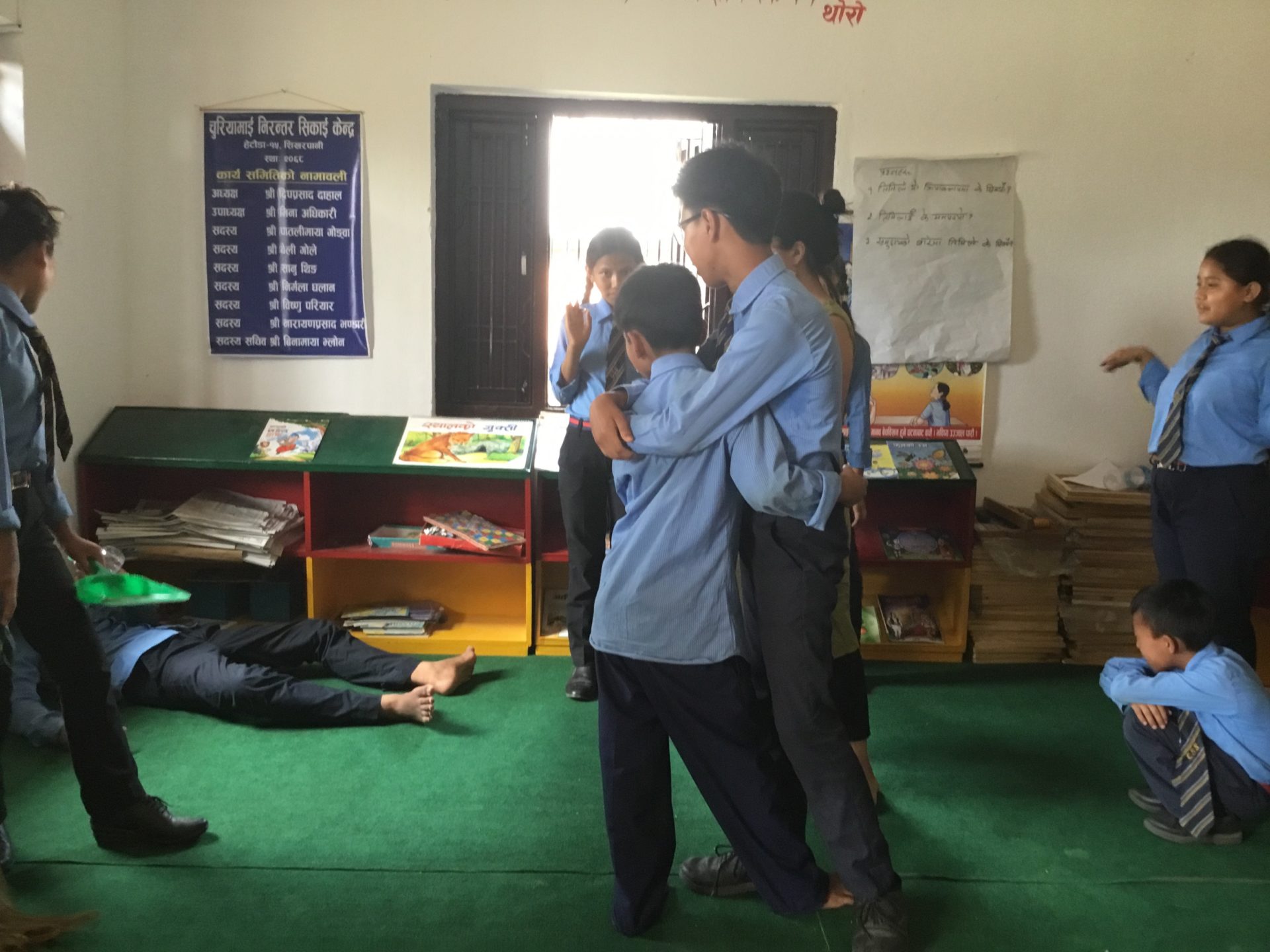
Credit: Marlon Moncrieffe
Discussion
There are many comparative opportunities for our project. In each country, we managed to apply the Scheme of Work in two very different schools (urban and rural) (state and private). This allowed us to understand more about the pedagogical variations adopted by teachers in each school with further comparisons of traditional to experimental approaches in teaching and learning. The cultural capital of the teachers and the students were also significant factors in determining the engagement with the Scheme of Work. We ensured that the Scheme of Work document was written in three different languages: English, Nepali and Swahili. This ensured connection and equity in empowering all teachers to facilitate the lesson plans.
Our Civil Society Organisation participants in attendance as spectators were keen to learn more about the research process. This project has brought for them an alternative approach in the selection of performance arts tools in relation to education and peacebuilding with young people (For more on this read the blogs by two young changemakers working on the project). Although the practices and approaches were new to so many, the participants actively engaged with activities using Ipads as their digital diaries of reflection, and participatory approaches founded on child-centred teaching and learning.
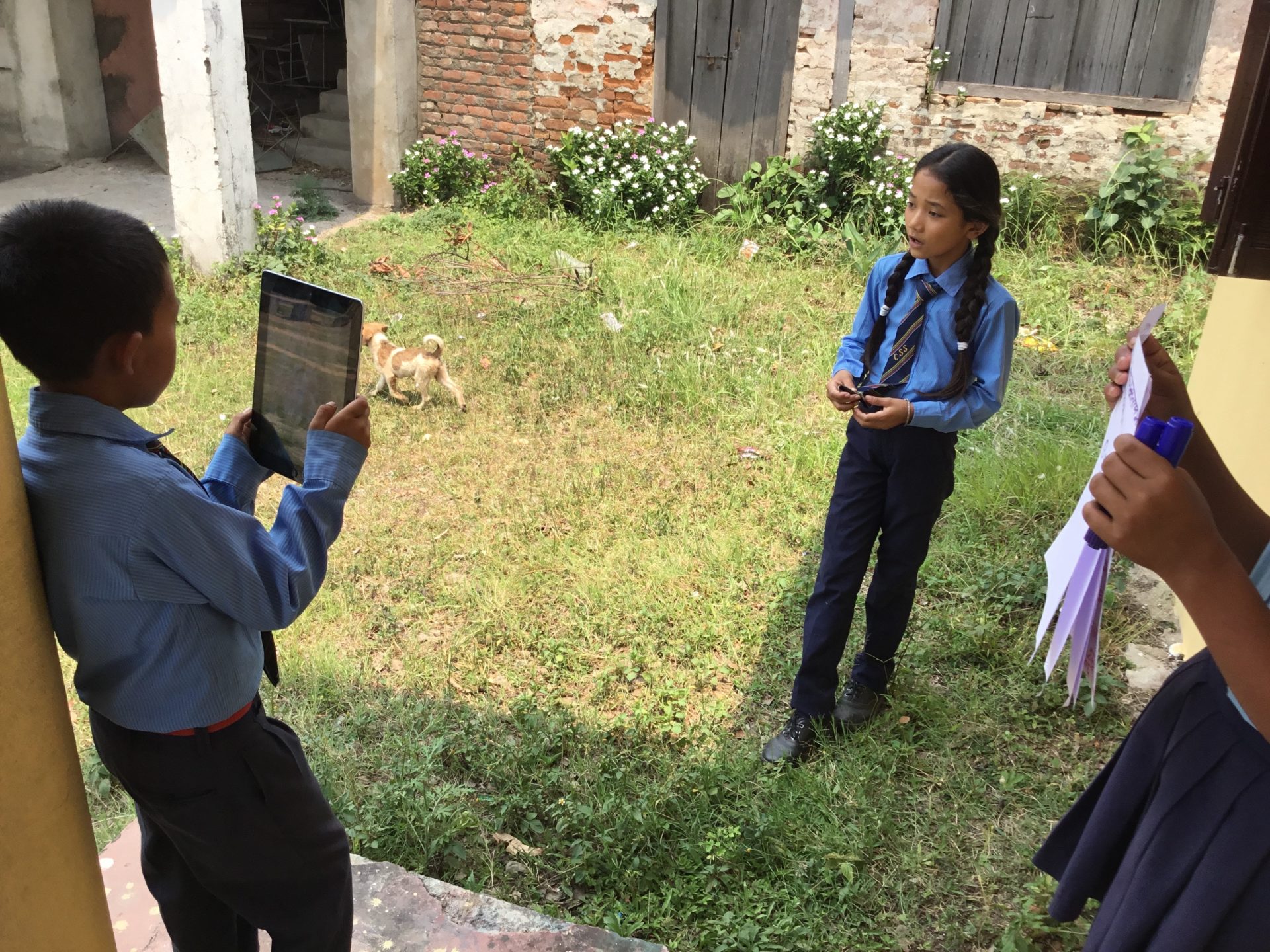
Credit: Marlon Moncrieffe
[Nepal explosion kills four in capital] This incident occurred as we began our research in Nepal. As a team it made us critique the term ‘Post-Conflict’ especially where we were told that the suspects of the attack were Maoist Splinter Group linked closely to deep conflict of the past. It reminded us the issues faced by people in this country are indeed relatively current. The explosions caused deaths and a resulting ‘strike’ which slowed Kathmandu. Lack of transport to the city and within it prevented teachers and partners from attending our pre-conference meeting and seminar session.
From gaining our data we reminded ourselves not to draw generalisations from two schools in each country, but to think more carefully about how we assess the children’s work through the processes of the SoW. We also reminded ourselves that a critical stance must be adopted towards our SoW. We see our project both as a research and development project.
Next steps
The aim of Lesson 4 is for the films made to date to shown at each school. Following this, the young people involved will write their reflections; the aim being to share their thoughts on the cross-cultural exchanges and their new knowledge and interpretations of civic national values through hearing the voices of their peers in hard to reach parts of their country. What are the commonalities in their voices? What do they learn from each other about community, mutual respect and tolerance? Lesson 4 will facilitate thinking, discussion and shared articulation on how young people’s interpretations of civic national values can be advanced further towards a sense of connection and belonging with national identity at a macro community level.

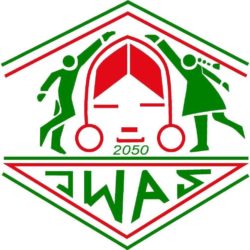
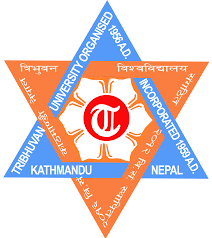

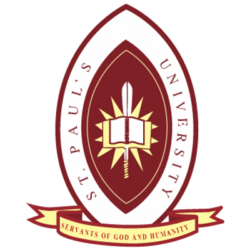

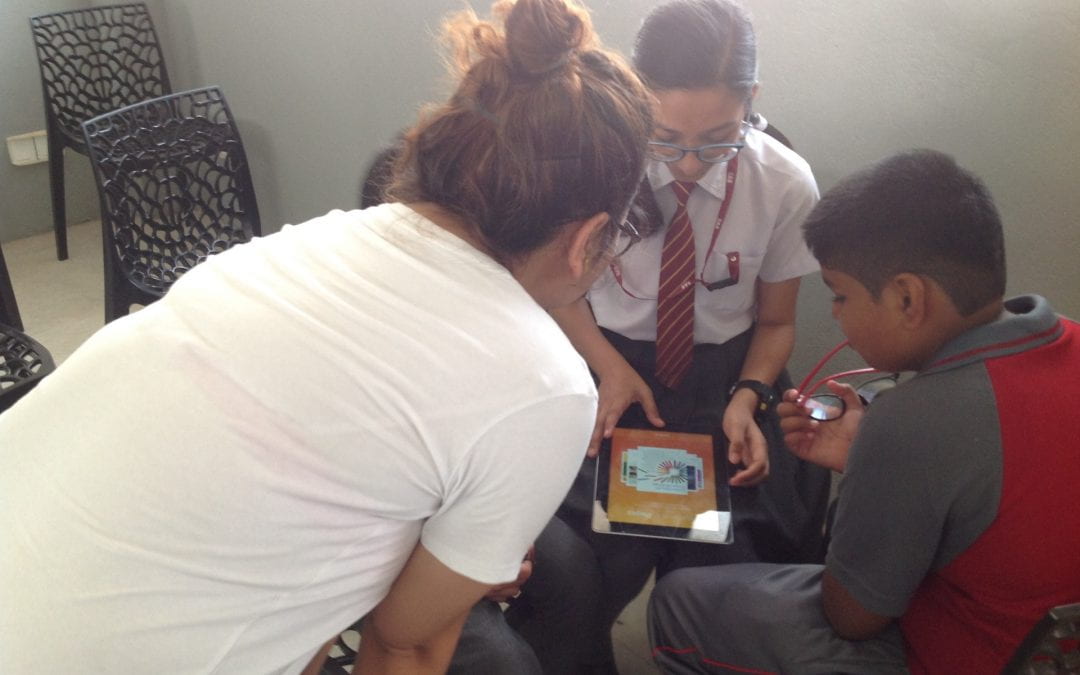
Mar 23, 2020 | Blog, MAP archive, Peace Education, Related Activities & Initiatives
This post was originally published via Changing the Story (CTS)’s #YoungChangemakers series on 1st October 2019, as part of the CTS sub-project Examining the Interpretations of Civic National Values Made by Young People in Kenya and Nepal.
Changing the Story is an AHRC GCRF project which asks how the arts, heritage and human rights education can support youth-centred approach to civil society building in post-conflict settings across the world. The ‘Examining the Interpretations of Civic National Values Made by Young People in Kenya and Nepal’ was closely linked to the methodologies used in the CTS MAP project, and contributed to Nepal becoming one of MAP’s current country focus. Find out more about Changing the Story and see the original post here: https://changingthestory.leeds.ac.uk
Written by Pramila Bisunke.
When I (first) heard the title of the project (Examining the Interpretation of Civic National Values made by young people in Nepal and Kenya), I was literally perplexed thinking what this is really about.
My role at Changing the Story
In this particular project I was responsible for administration and documentation. I started by going through the documents about changing the story, program content particularly in case of Nepal and its projects in different countries such as Kenya, Zimbabwe, Colombia, Rwanda, Kosovo and Cambodia etc. We were supposed to pilot (our project) in two schools; one rural and one urban. (My role involved) communicating with the schools and (translating) the documents we had about the project: about Changing the Story, information sheets, consent forms for children and lesson plans for teachers etc. needed to be translated from English to Nepali for field work preparation. It was only through doing this I got the gist of what we were supposed to do while simultaneously still wondering how it (would) work. (I started to) document planning meetings, seminars in Tribhuvan University, sessions in schools and review meetings. I prepared meeting notes and disseminated among the people involved in the project and my understanding about project got even better.
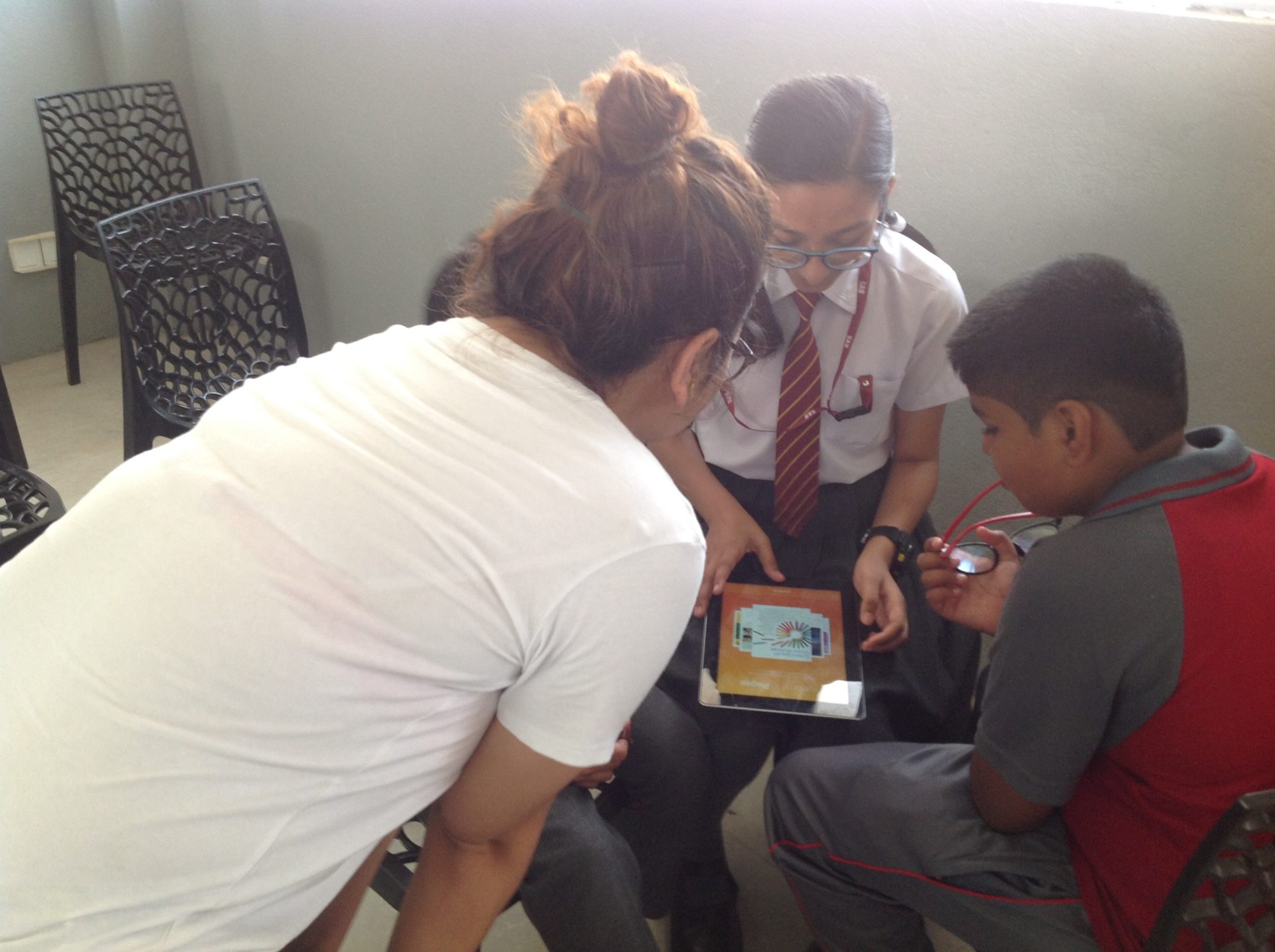
I grew up in such school environment where I just sit on the bench and listen to the teacher. Even today, I believe more than half of the schools follow the same teaching method. I will not say this method of teaching is the best in today’s context. Because the concept of teaching and learning is not only limited to student listening and teacher speaking, it is now more about (the) participation of students and using various artistic methods to learn as well as apply the learning better in life.
Working on the documents in our own local language gave me the concept of new methods in teaching along with the use of technology i.e. Ipad. During the fieldwork when I engaged in the activities (I saw) fun group work among students, their own lessons on community and moral education from their course book, reflections on their actual concept of community, living in harmony, equality regardless of gender, background, caste, culture and profession. Moreover, their capacity to reflect their thoughts into community context through arts such as drama, poetry and songs were amazing. It was all smiles on their faces after the activities.
I believe such projects need to be demonstrated in as many schools and countries as possible to adapt the teaching methods in schools. In addition to that, the teachers should be trained in such a way that the learning can be fun rather than memorizing the textbook. This will be a major educational change if we can adapt the teaching methods to the present context of post conflict settings. Particularly in post conflict because people have been displaced or migrated from one place to another, therefore the society is more mixed up in between rural and urban, people from different backgrounds. As the title says Changing the Story, it might help young people to learn about respect, harmony, peace, equality, non-discrimination from the schooling age in more practical ways that they learned through their own engagement.
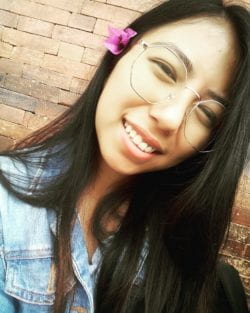
Mar 23, 2020 | Blog, MAP archive, Peace Education
This post was originally published via Changing the Story (CTS)’s #YouthChangemakers series on 1st October 2019, as part of the CTS sub-project Examining the Interpretations of Civic National Values Made by Young People in Kenya and Nepal.
Changing the Story is an AHRC GCRF project which asks how the arts, heritage and human rights education can support youth-centred approach to civil society building in post-conflict settings across the world. ‘Examining the Interpretations of Civic National Values Made by Young People in Kenya and Nepal’ was closely linked to the methodologies used in the CTS MAP project, and contributed to Nepal becoming one of MAP’s current country focus. Find out more about Changing the Story and see the original post here: https://changingthestory.leeds.ac.uk
Written by Samjhana Balami
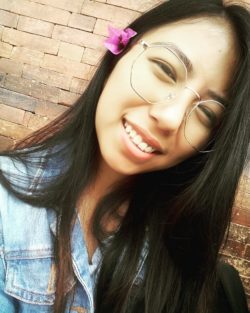 Hello, I am Samjhana Balami from Nepal, currently a management student and a freelancer. I am an introvert in nature but always ready to learn if get a chance. In the process of learning, some months ago, I got a chance to assist ‘Young Changemakers CTS Kenya-Nepal Phase 2 program’ project.
Hello, I am Samjhana Balami from Nepal, currently a management student and a freelancer. I am an introvert in nature but always ready to learn if get a chance. In the process of learning, some months ago, I got a chance to assist ‘Young Changemakers CTS Kenya-Nepal Phase 2 program’ project.
Being an undergraduate student the project theme was vague for me to understand and was beyond my course curriculum and work area. My role was centered on photography, videography and filmmaking. Being a fresher at first I was nervous as I met experienced, talented people involved in this project. I also had a feeling that I do not belong to this project but the first meeting with the team gave me confidence to carry on with the work. Everyone was so humble, down to earth and fun too. With such great team members I got a great opportunity to learn and improve myself.
Although my role was on film making, I was equally given a chance to interact with the audience. I wasn’t bound to my role only. The field work in urban and rural schools created a kind of nostalgia for me. When I was a student in school, I was supposed to focus more on my textbooks. The case was not only of mine but of the whole education system. We, the students were guided as per the syllabus of the textbooks only. Extra curricular activities (were considered) a learning platform but only textbooks were a source for academic teaching. Being the part of Changing the Story (CTS) I found that teaching could be done with various means and resources. I have never thought art could also be a medium for teaching. I was astonished to see how the students were learning about the civic values through the medium of art. Both the technology and art used in teaching during the CTS program could set a reference to our education system.
During all the sessions, I found excitement and interest in every student to learn something different. Everyone was active and giving their best in each tasks. I have seen the joy and amazement in them when the technology and arts were used in teaching and learning. The Ipad introduction and its use in reflection recording, community understanding reflection through graffiti art/dramas/poems/songs, several creative games etc gave them a platform to share their thoughts, talents and also advertise their knowledge. Though the session was for a day I could sense the learning will benefit them throughout life because at such small age they are given ideas and knowledge on civic values which is very rare in our country context.
The activities were fun as well as an effective learning platform for both the students and us. It was a great experience being a part of such an amazing project with amazing, enthusiastic people. This project gave me the knowledge of ‘Learning by Doing’. It became a great opportunity to learn the scenarios about which I was unaware. It changed my perception towards teaching and learning. It made me realize how the technology and arts could be a medium in academic activities. I got an opportunity to personally experience the situation of education system of two different sectors; Urban & Rural. It added an experience to my career and helped to improve my skills. I believe, the things that I have learned should also be the learning of others. As it has changed my way of thinking regarding education, it could also bring changes in others as well the system.
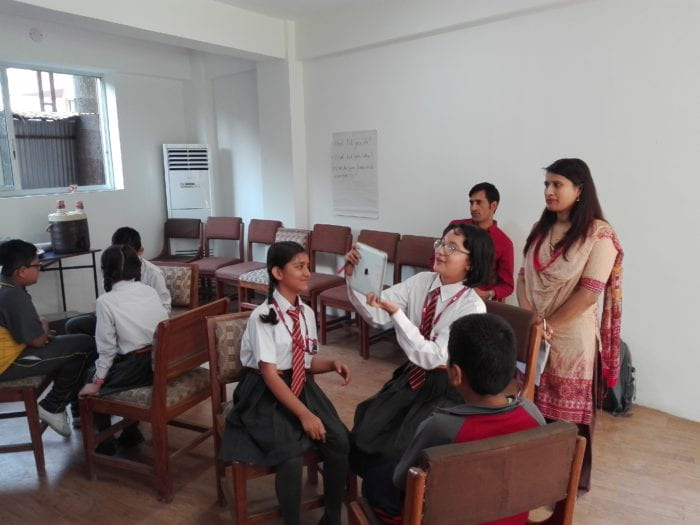
Mar 23, 2020 | Blog, MAP archive, Peace Education
This post was originally published via Changing the Story (CTS) on 20th December 2019, as part of the CTS sub-project Examining the Interpretations of Civic National Values Made by Young People in Kenya and Nepal.
Changing the Story is an AHRC GCRF project which asks how the arts, heritage and human rights education can support youth-centred approach to civil society building in post-conflict settings across the world. The ‘Examining the Interpretations of Civic National Values Made by Young People in Kenya and Nepal’ was closely linked to the methodologies used in the CTS MAP project, and contributed to Nepal becoming one of MAP’s current country focus. Find out more about Changing the Story and see the original post here: https://changingthestory.leeds.ac.uk
Written By Nub Raj Bhandari (Janaki Women Awareness Society)
Co-I, Examining the Interpretations of Civic National Values Made by Young People in Kenya and Nepal
Project Summary
Two decades of internal conflict and instability in Nepal has brought a drastic reformation in the state structure from central government to federal state including the education system. The school education is divided into two levels: basic (up to 8th grade) and secondary education (9th – 12th grade). Moral education is included in the curriculum of basic education aiming to inform young children about civic national values such as citizenship, social and moral behavior, tolerance and mutual respect. The local government units (LGUs) are responsible for the formation as well as implementation of regulations related to education. Besides the efforts of the central government to reform learning, LGUs, educational institutions and civil society organizations (CSOs) were also seeking opportunities to engage young children in the learning process in post conflict communities. To inform and advance policy making at local (LGUs) and national level on the interpretations of civic national values made by young people, we devised Schemes of Work consisting of reflections-actions-performances-recording and tested them in two schools. The schools and participants were selected randomly from distinct setting: rural/urban, public/private and English medium/Nepali medium. Six young students each from grades six, seven and eight grades, two teachers and two CSOs were selected randomly from each school.
Engagement of CSOs
The selection of CSOs was purposeful. In each school (rural and urban), two CSOs were invited to observe the research process. They overtly observed the engagement of young children and teachers in the arts based methodologies (reflections, actions, performances and recording). Based on a set of open-ended questions, the CSOs provided a reflective overview on the arts based methodologies, overall research process and content.
Reflections of CSOs over the research process
At the planning phase, there were two questions concerning the engagement of CSOs in the research process. The first was ‘whether the CSOs accept arts based engagement of young children as a process of teaching and learning? Similarly, the second question was, ‘how could the engagement of CSOs in the research process add value to the project?’ The reflections from the CSOs showed that their engagement was an essential part of the project. ‘I am wondering, how can I apply these steps in my work?’ was the concern of one CSO participant. While young children were drawing to illustrate their vision of a model community, CSO participants expressed their interest to integrate the activity into their own work at schools. The drawing, according to a CSO, ‘is the best way of engaging students and teachers in the learning and teaching process’. They expressed their interest to learn more about the SOW; ‘I should learn more about the arts based methodologies’, said one urban CSO. Similarly, ‘can we work together on similar project in future’, was the interest of rural CSOs.
According to CSOs, lessons on reflection and performance help young children to learn fast. ‘Everyone is actively participating, so these forms of creative engagement are a better way of engaging young people in the learning processes’ was the common response of CSOs. Though they were watching the actions and performances of young people, they spoke much about engaging adolescents and adults in their community based civic education projects. However, CSO participants know that it is not easy for Nepali CSOs to follow these lessons in their development projects. It could be a challenge to organize multiple opinions of different groups because research is not the common working arena for CSOs in Nepal. Therefore, when they return to their actual work, it could be a challenge for them to integrate the theory of the research they have experienced. However, every opinion made by CSOs in this research project is praiseworthy and it is also a positive indication for the follow up activities based on arts based methodology.
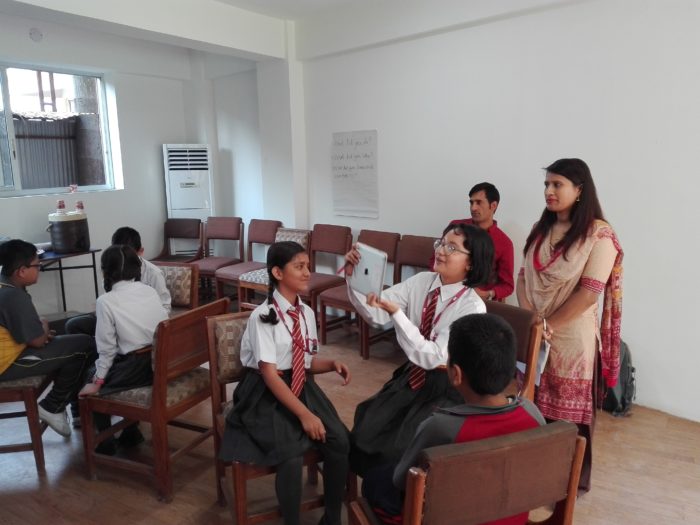
CSO participant observing the research process. Photo credit: Nub Raj Bhandari
Concluding remarks and way forwards
The observations of CSOs throughout the research process from lesson one to four of the SOW’s (reflections, actions, performances and recording), endorse the arts based methodology as a successful research tool to engage people for constructive learning in the post conflict context. CSOs’ keen interest for including the arts based methodologies and SOW in their work could be considered a further step towards sustainability of the process.
With the above reflections, the way forward for future similar projects would be to provide a space for CSOs in the research process to improve their understanding of arts based methodology at a deeper level. This could be done through engaging them in pre-planning meetings, orienting them about the research process well before the fieldwork and engaging them as facilitators as well. CSOs engagement in the pre-planning meeting and orientation will enhance their understanding of the differences between their CSO project and a research project. The facilitation will strengthen them their interest in integrating arts based methodologies in their regular project, which will further support the sustainability of arts based approaches in the post conflict countries.
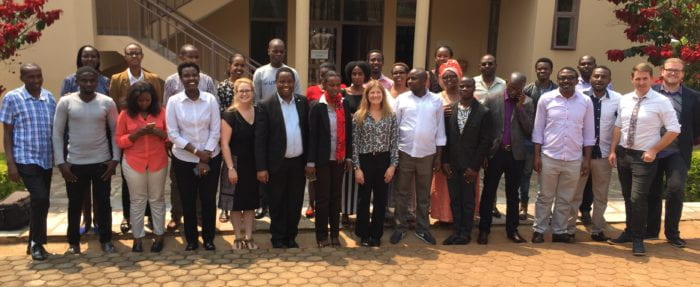
Mar 23, 2020 | Blog, MAP archive, Peace Education
This post was originally published via Changing the Story on 19th March 2020. Changing the Story is an AHRC GCRF project which asks how the arts, heritage and human rights education can support youth-centred approach to civil society building in post-conflict settings across the world. The development of the MAP project was a major output of Changing the Story and the two projects continue to work closely together. Find out more about Changing the Story and see the original post here: https://changingthestory.leeds.ac.uk
The role of arts for peacebuilding initiatives has influenced major research and civil society organisations both nationally and internationally. Some of the benefits of arts-based approaches includes the opportunity to create innovative approaches for community dialogue alongside the development of skill building in the performing arts more generally. Mobile Arts for Peace (MAP) is one such initiative in Rwanda, spearheaded by Dr. Eric Ndushabandi from the Institute for Research and Dialogue for Peace (IRDP), Prof. Dr. Ananda Breed from the University of Lincoln and the Rwanda Education Board (REB) to inform the national curriculum framework in Music, Dance and Drama.
MAP delivered arts-based curricula from March 2018–January 2019 in the Eastern Province of Rwanda to inform the national curriculum framework as the Phase 1 practice-as-research project for Changing the Story. In 2019, Breed was awarded £100,000 AHRC Follow-on impact funding as Principal Investigator for the extension of MAP from the Eastern Province to the other four provinces in Rwanda, including the Northern Province, Western Province, Southern Province, and Kigali Province to incorporate all regions in Rwanda. To date, cultural artists, educators and young people have informed the development of a 250-page training manual that has been translated into Kinyarwanda and established numerous drama clubs alongside the incorporation of MAP into the curriculum.
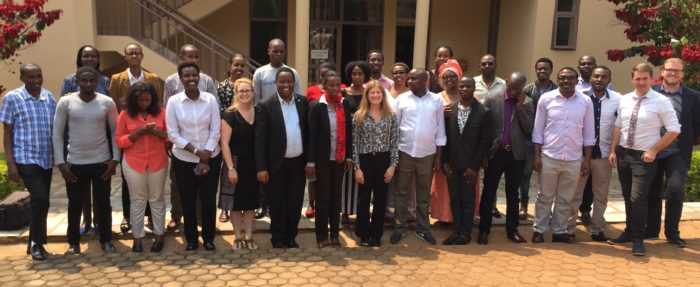
Participants in the stakeholder meeting in Kigali, January 2019
On 23 January 2019, the IDRP launched their role as co-investigator of MAP at a stakeholder meeting in Kigali, Rwanda attended by the Rwanda Education Board (REB), Ministry of Education, Ministry of Sports and Culture, Ministry of Youth, Ministry of ICT and Innovation, and numerous distinguished guests. Mrs. Joan Umurungi from REB served as the guest of honour. Umurungi commented on the importance of arts for peacebuilding and educational processes. Additionally, REB representatives noted their endorsement of MAP as a key partner and how MAP aligns with the vision of the Ministry of Education concerning the development of the competence–based curriculum. The Ministry of Sports and Culture noted the importance of MAP to develop the creative industries nationally. Ministry representatives noted that MAP is practical, grassroots based, and brings a sense of ‘life’ in terms of conflict prevention and the promotion of dialogue through an arts-based approach. Noted endorsements included the ability for MAP to enhance peace values, public speaking, inclusive education and to develop a society that assists with healing. Speakers included: Dr. Eric Ndushabandi from IRDP; Dr. Sylvestre Nzahabwanayo from the College of Education, University of Rwanda; Dr. Samuel Rushworth from Aegis Trust; Mrs. Amy Barnecutt from A Partner in Education; Mr. Jeymo Mutinda from Music Mind Consult; Mr. Victor Ntezirembo from IRDP and Ms. Laure Iyaga from Sana Initiative. Presentations and workshops were based on the use of arts with and for young people in peacebuilding initiatives.
The national competence-based curriculum in Rwanda from primary to upper secondary (2015) includes Music, Dance and Drama as a subject, although at the time of writing there is no provision of curriculum nor training available. In addition to integrating Music, Dance and Drama into the curriculum, the competence-based curriculum promotes participative and interactive methods stating: ‘Teachers need to shift from traditional methods of instruction and adopt participatory and interactive methods that engage young people in the learning process, both in groups and as individuals. This ensures that learning is active, participative and engaging rather than passive, and that it is personalised, addressing learners’ individual needs and expectations’ (Ministry of Education 2015: 73). To address some of these stated needs and objectives, MAP coordinated a series of activities.
MAP activities in 2018 included a pilot project in the Eastern Province of Rwanda working with ten cultural organisations, five schools, twenty-five adult trainers and ten youth trainers. Following a series of activities including a scoping visit, curriculum workshop, training of trainers and youth camp, the MAP methodology was disseminated to 62 educators and 526 young people on a weekly basis. The methodology incorporates the use of participatory arts for trust building, teamwork, facilitation, leadership, and public speaking. The methodology incorporates mental health awareness and conflict negotiation skills alongside skill development in characterisation, improvisation, voice and movement. In addition, MAP incorporates Music, Dance, Drama and the Visual Arts using an interdisciplinary approach.
In a presentation delivered by Nzahabwanayo, he reported key data collection findings derived from ten interviews with MAP adult trainers, nine interviews with MAP youth trainers, and six interviews with MAP cultural artists. Key findings included:
- MAP has contributed significantly to the improvement of the learning processes of high school students.
- MAP has empowered them with public speaking skills. They are now able to argue for a case and voice their opinion publicly.
- MAP has improved the academic performance of students. Some say that before engaging with MAP they used to be lazy in the classroom. But after MAP, they learn enthusiastically; they try to link what they learn with their daily life and this contributes greatly to their academic achievement.
- MAP has improved parent and student relations. Students stated that before engaging with MAP, they were fearing their parents and were only receiving instructions. After MAP, they have acquired skills to engage in a dialogue with their parents on different issues and come to a consensus.
- MAP has enabled them to identify some major problems prevailing in their community, and students feel called upon to contribute in addressing these problems.
In an interview conducted by Breed on 29 November 2018 with a twelve-year-old youth participant of MAP, she stated:
With MAP, we have confidence to act and contribute. Not only has it influenced me as a person, but by applying the techniques, I’ve been able to realise that I’m empowered. I learned through MAP that the more that I voice my opinion, the more I’m understood.
In an interview conducted by Breed on 28 November 2018 with a twenty-five–year–old adult educator from Friends of the Children International School, Hassan Ngendahimana, stated:
After the training of trainers, we worked with our school children. They were motivated and developed skills. Among the teachers, we now have a drama team. We teachers are capable to train the children in drama. The impact of MAP in our schools is seen through what we are doing.
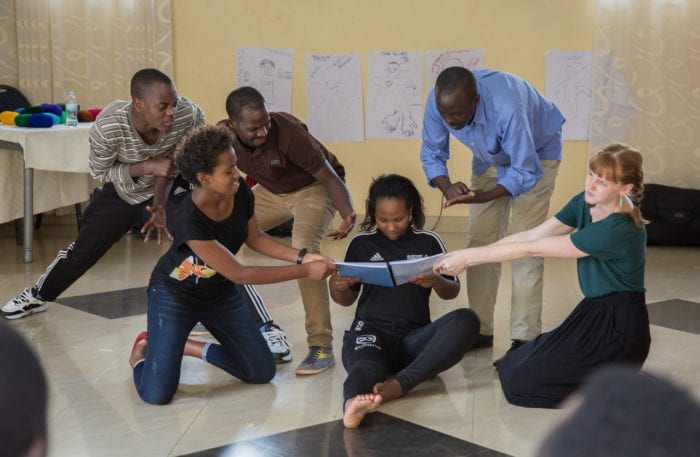
Mar 23, 2020 | Blog, MAP archive
This post is a rework of the March 2019 MAP newsletter.
This post is a re-post of the MAP newsletter of March 2019.
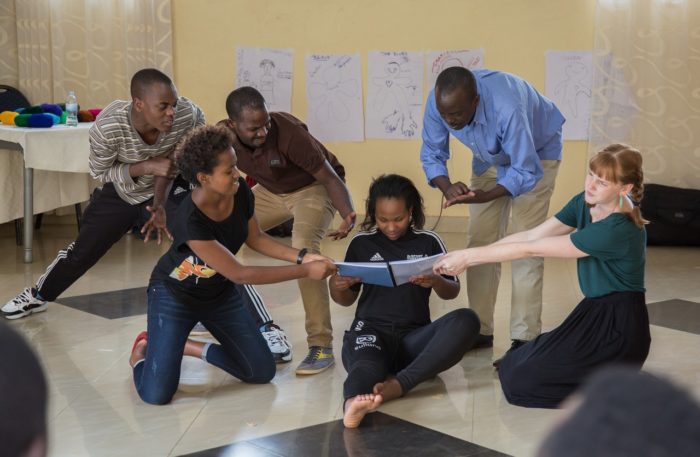
Facilitators at the training of trainers make a tableau, or frozen image, August 2018. Photo: Deus Kwizera
In 2018, MAP was launched in the Eastern Province of Rwanda. Initial activities included a curriculum workshop with cultural artists to inform the methodology, a training of trainers with educators to adapt the methodology to local and regional contexts, and a youth camp to train young people as facilitators working alongside the adult educators to develop drama clubs and to integrate the methodology into schools.
In Rwamagana, MAP worked with five schools, ten cultural organisations, twenty-five educators, and ten young people to design and deliver the MAP methodology. Following the training events, youth and adult trainers extended the training to an additional 62 educators and 526 young people by the December 2018.
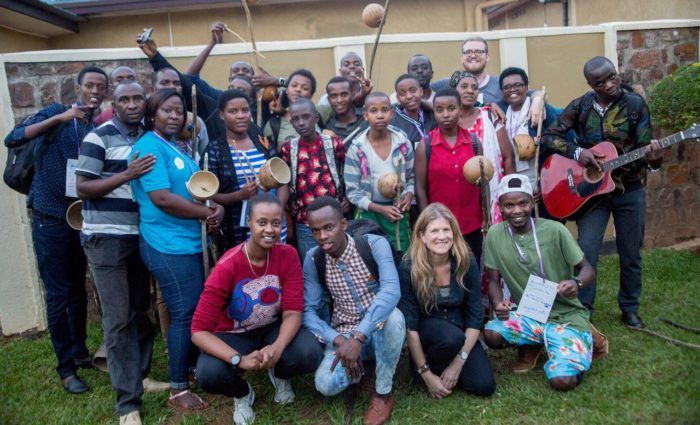
Teachers, cultural artists and young participants gather for a photo at the youth camp, December 2018. Photo: Deus Kwizera
What’s Next in 2019?
Countrywide Expansion
Thanks to AHRC follow on impact funding, MAP youth and adult trainers from Rwamagana district will train adult educators and young people in Gicumbi, Rubavu, Nyamasheke, Huye and Kicukiro using the same structure as the pilot phase.
Small Grants
In order to support their extraordinary success, MAP adult and youth trainers have been invited to apply for small grants that can help to deliver ongoing training; to initiate drama clubs; and to expand MAP to other schools, communities and districts in the Eastern Province.
Mobile Filmmaking
MAP adult and youth trainers will participate in a Mobile Filmmaking workshop conducted by Eric Kabera of Kwetu Film Institute in April 2018. Mobile phones will be given to each of the participants to document, edit and produce short films.
Partner Highlights: Sana Initiative
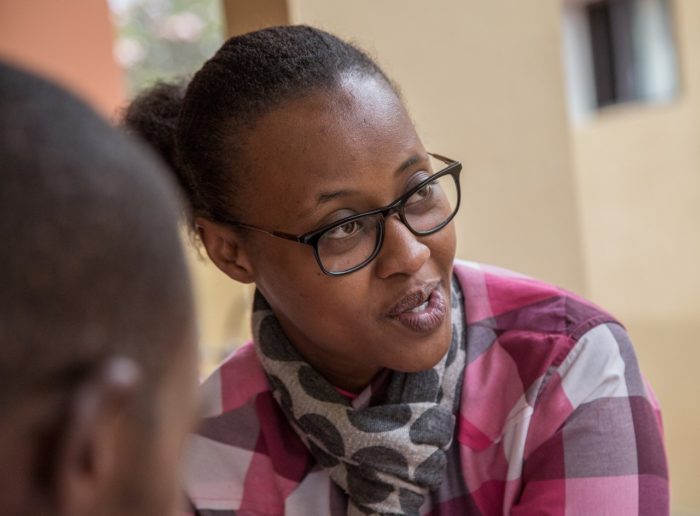
Laure Iyaga speaks to facilitators about sojourning, August 2018. Photo: Deus Kwizera
Thanks to Laure Iyaga, MAP is a peace building initiative in Rwanda that integrates mental health awareness and support for its participants.
In addition to offering workshops and counselling during MAP activities, Sana offers ongoing support to MAP youth and adult trainers.
Ms Iyaga stated: ‘The equality among trainers and trainees creates a safe space and is working to heal deep wounds from the lack of a support system experienced by many young people.’
Learn More about Sana Initiative and their work in a broader Rwandan context by following this link.
24 January Stakeholder Meeting
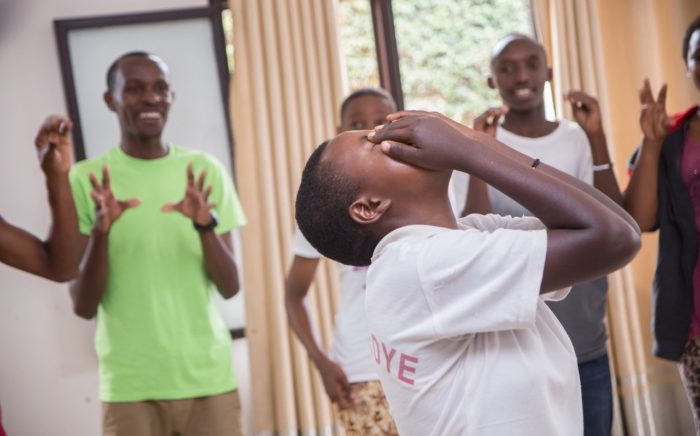
A young participant leads and activity during the youth camp, November: 2018. Photo Deus Kwizera
On 24 January 2019, the Institute for Research and Dialogue for Peace (IRDP) launched their role as co-investigator of Mobile Arts for Peace (MAP) at a stakeholder meeting in Kigali, Rwanda attended by the Rwanda Education Board (REB), Ministry of Education, Ministry of Sports and Culture, Ministry of Youth, Ministry of ICT and Innovation and numerous distinguished guests. Mrs. Joan Umurungi from REB served as the guest of honour. Mrs. Umurungi commented on the importance of arts for peacebuilding and educational processes. Additionally, REB representatives noted their endorsement of MAP as a key partner and how MAP aligns with the vision of the Ministry of Education concerning the development of the competence based curriculum. MAP enhances peace values, public speaking, inclusive education and develops a society that assists with healing.
MINISPOC noted the importance of MAP to develop the creative industries nationally. Ministry representatives noted that MAP is practical, grassroots based, and brings a sense of ‘life’ in terms of conflict prevention and the promotion of dialogue through an arts-based approach. Speakers included: Dr. Eric Ndushabandi from IRDP; Dr. Sylvestre Nzahabwanayo from the College of Education, University of Rwanda; Dr. Samuel Rushworth from Aegis Trust; Mrs. Amy Barnecutt from A Partner in Education; Mr. Jeymo Mutinda from Music Mind Consult; Mr. Victor Ntezirembo from IRDP, Ms. Laure Iyaga from Sana Initiative, Dr. Ananda Breed from the University of Lincoln and Kurtis Dennison, MAP Project Manager. Presentations and workshops were based on the use of arts with and for young people in peacebuilding initiatives.
The role of arts for peacebuilding initiatives has influenced major research and civil society organisations both nationally and internationally. Some of the benefits of arts-based approaches includes the opportunity to create innovative approaches for community dialogue alongside the development of skill building in the performing arts more generally.
Initial Research Findings from Dr. Sylvestre Nzahabwanayo
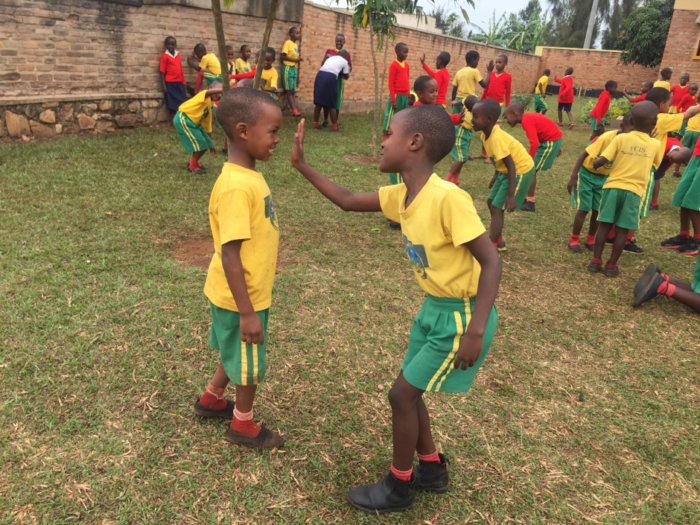
Young people participate in MAP activities at a Rwamagana Schoool, September 2018. Photo: Kurtis Dennison
Dr. Sylvestre Nzahabwanayo from the College of Education, University of Rwanda provided the following research findings based on interviews and focus groups with MAP youth and adult trainers, cultural artists, and stakeholders:
MAP keeps us awake in the classroom
Students reveal that by engaging in MAP activities amid a busy day with lessons, they are kept awake and do not feel sleepy. Given the introduction of the module system in advanced level in high schools (where a lesson can take up to 5 hours), it is important to keep students’ momentum.
MAP has enabled us to speak in public
The vast majority of students admit that before engaging with MAP they could not stand in front of their peers and make an argument. MAP has empowered them with public speaking skills. Students who were shy in the classroom confess that they can now raise questions to the teacher.
MAP has raised my marks
Preliminary findings of this study show that MAP has improved the academic performance of students. Some say that before engaging with MAP they used to be lazy in the classroom. But after meeting MAP, they learn enthusiastically; they try to link what they learn with their daily life and this contributes greatly to their academic achievement.
MAP has allowed me to engage with my parents
Students tell that before engaging with MAP they were fearing their parents and were only receiving instructions. After participant in MAP, they have acquired skills to engage in a dialogue with their parents on different issues and come to a consensus.
I am attentive to what happens in my society
The vast majority of students affirm that before engaging with MAP they were indifferent to fundamental problems of the Rwandan society. Students admit that after participating in MAP trainings, they are now awake to what happens around them.
After the training of trainers, we worked with our school children. They were motivated and developed skills. Among the teachers, we now have a drama team. We teachers are capable to train the children in drama. The impact of MAP in our schools is seen through what we are doing.
-Hassan Ngendahimana, Friends of the Children International School
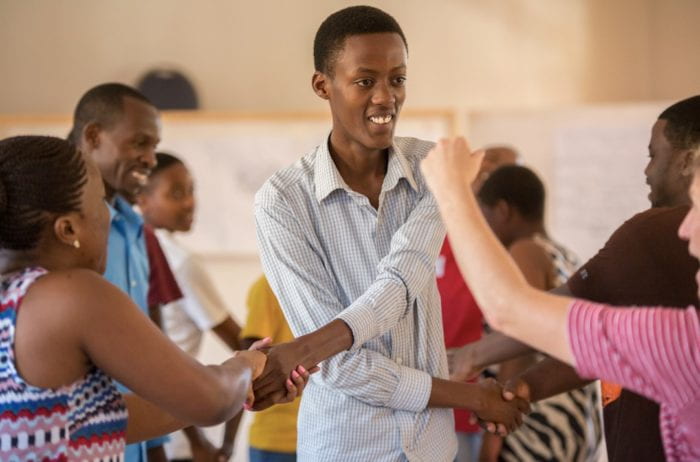
Mar 23, 2020 | Blog, MAP archive, Peace Education
This post is a rework of the May 2019 MAP newsletter.
Take a look at what the MAP team have been up to so far in 2019.
Drawing Inspiration from Young People
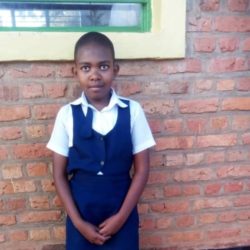
The artist, Ganza Daniella. Photo Hassan Ngendahimana.
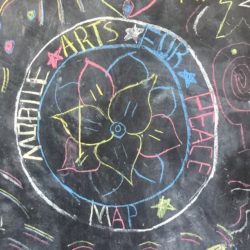
The original image that Ganza drew on a chalkboard.
January, 2019. Photo: Kurtis Dennison.
It was on a field visit to Friends of the Children International School after the January Stakehold meeting where the identity of MAP would forever be immortalized in our new logo designed by Ganza Daniella and rendered by Sinclair Ashman of the University of Lincoln. The students, excited to be getting a visit from the MAP team, welcomed the visitors with songs and drawings. While there were many wonderful drawings on paper and on the chalkboard, one image stood out: a flower.
A flower wasn’t the first image the project team would immediately associate with peace, but for this project, it made so much sense. A flower has to grow, and when it grows, it opens up to show its beauty much like MAP helps young people open up and express themselves. This project works with many partners (or petals) who are all necessary to the success of the project; the more petals, the more bountiful the flower. And through adaptation of cultural forms and creation of activities from Rwandan artists and teachers, the project is deeply rooted and cultivated by the people the project serves.
Ganza Daniella was thanked officially by the MAP facilitators at an award ceremony on April 27th. Her design will now be used to brand the project as we expand through the provinces of Rwanda.
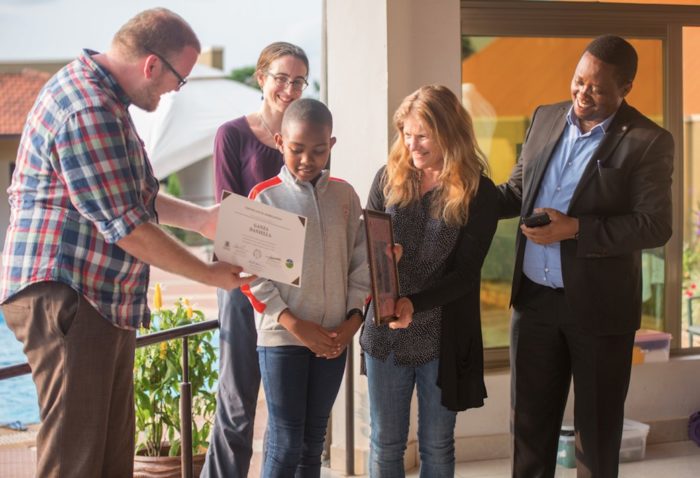
Project Manager Kurtis Dennison (IRDP), Principal Investigator of Connecting Memories Dr. Kirrily Pells (University College London), Ubwuzu Principal Investigator & Changing the Story Co-Investigator Dr. Ananda Breed (University of Lincoln) and Changing the Story Co-Investigator Dr. Eric Ndushabandi (IRDP) give Ganza a certificate and framed image of her design. April, 2019. Photo: Deus Kwizera.
Filmmaking for Peace? Eric Kabera’s Mobile Filmmaking Workshop
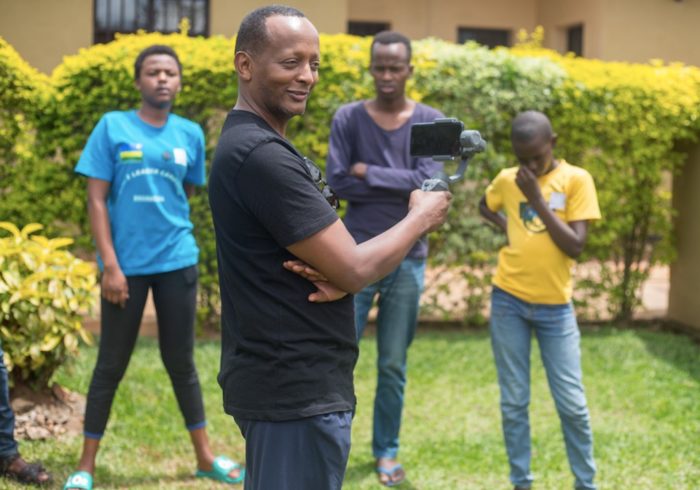
Eric Kabera holds his iPhone in a gimbal to demonstrate framing and movement in video making. April, 2019. Photo: Deus Kwizera.
Kwetu Film Institute and the Rwanda Cinema Center have been project partners of Mobile Arts for Peace since its inception. Since the beginning, an interactive workshop with world renowned film creator Eric Kabera has been planned. This April, this dream was finally realized.
Eric Kabera spent three days with the 16 MAP facilitators. Through exercises, the participants learned the basics of filmmaking including lighting, framing, storytelling, dialogue, mise en scène, and themes. The most impactful part of the workshop was the opportunity to hear the stories from Eric Kabera himself. Sharing a story of how he found inspiration once in a shoe, the most important lesson the facilitators learned was the need to be curious.
“I have learned that to make a film or a movie, you can have a plan and you can give the community strong story which can be interesting for them.” (-Sandrine, Rwamagana A)
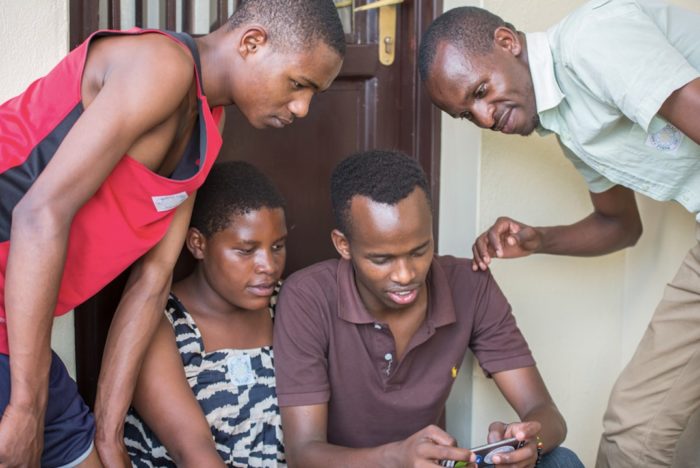
Leonard, Dorcas, Reuben and Claude review footage at the Mobile Filmmaking Workshop. April, 2019. Photo: Deus Kwizera.
We think filmmaking can be an accessible tool for young people to share the stories that affect them to larger and mobile audiences. With the growing status of technology and a phone being a device most people have access to, these tools can help us to to see the world through the eyes of young people. Because Rwanda is striving to emphasis their technological potential, we think this is a perfect location to start this work. By thinking about situations they encounter and themes they wish to explore, the young people will continue to develop their skills in filmmaking, peace building and dialogue.
This opportunity was just the start for the MAP participants. By the end of the workshop, each participant had created a fully realized short film using all the elements learned. Each school will receive an iPhone 6 to keep on site allowing them to document their MAP activities and make short films. The participants were also invited to apply to the Rwanda Cinema Center Film Festival in August.
“Before attending the filmmaking session, I spent many years asking myself how different people can take different [pictures], how some people take good [pictures] and some take bad [pictures]. I was curious to know the strategies. From the workshop, I was happy because my worries were answered. What I can say is that making a film or taking a video is not something you do once and stop. You must rehearse many times so it will stick in your mind and you will be familiar with it.” (Ngabbonziza, RLS)
See the film ‘Headphones’ created by Florence, Leonard, Sam and Assia:
Connecting Memories: a Participatory Action Research Project
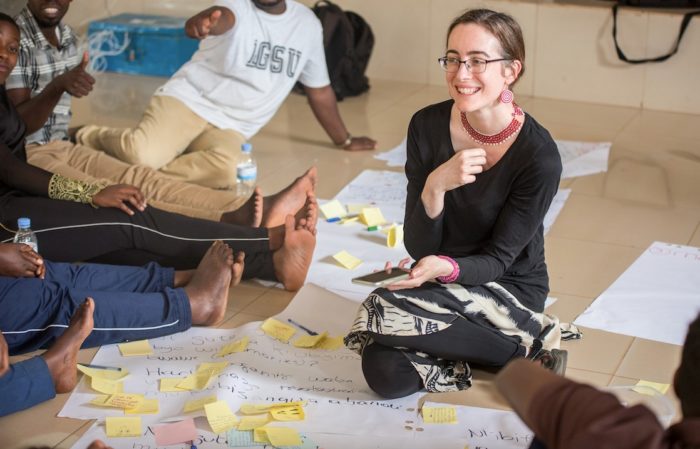
Dr. Kirrily Pells demonstrates data collection as young people and adult facilitators plan how they will conduct their research project. April, 2019. Photo: Deus Kwizera.
Connective Memories (CM) is a Participatory Action Research (PAR) project working alongside MAP. It is a collaboration between University College London (UCL) Institute of Education, IRDP, Uyisenga N’Imanzi and MAP. CM is adapting and extending the MAP methodology to a PAR project for two purposes. First, to engage youth and adult MAP facilitators in a co-designed PAR project on the broad theme of “memories” with the intention of fostering space for intergenerational dialogue through the creative arts. Second, to train youth and adult facilitators in PAR so that they have the skills to research and evaluate the impact of the MAP clubs in their schools.
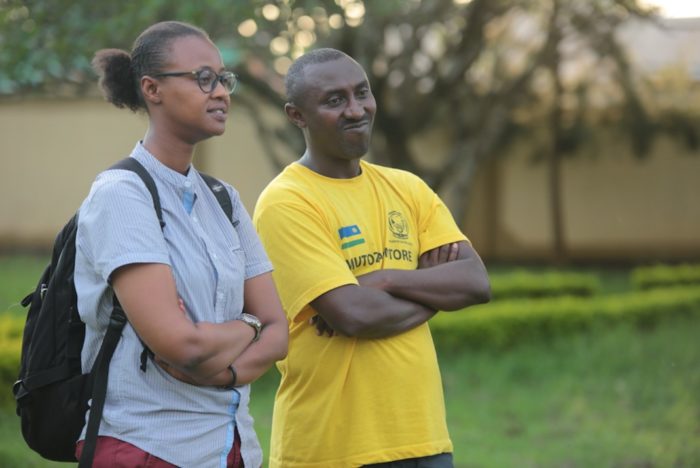
Ms. Laure Iyaga (Sana Initiative) and Mr. Chaste Uwihoreye (Uyisenga Ni Imanzi) observe youth participation to help with group dynamics and mental health support. April, 2019. Photo: Deus Kwizera.
The first workshops was held training 10 youth and 6 adults in PAR and co-desiging a research project on sharing “memories” or “isangizanyankuru”. We were then joined by another 20 young people from Uyisenga N’Imanzi and the groups of young people worked together to create performances based on issues affecting youth in their communities. On the final day the performances were shared with community members and dialogues facilitated by IRDP with adults and youth. This project also started the integration of community dialogues, a project long held by IRDP, in to the MAP methodology. The project will continue over the next few months as we work with the young researchers to analyse the data and we look forward to sharing the findings with you soon!
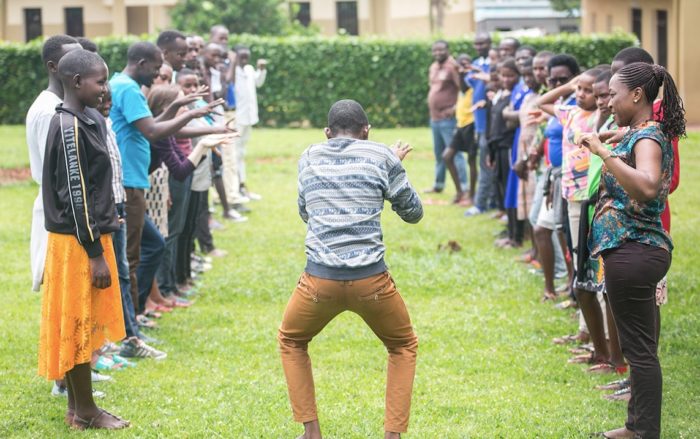
MAP Facilitator Leonard leads youth from Uyisena Ni Imanzi through the activity Kabish Kaboo. April, 2019. Photo: Kurtis Dennison.
Understanding the Project Structure: Co-Investigators and researchers attend the Network Plus meeting in Cambodia.
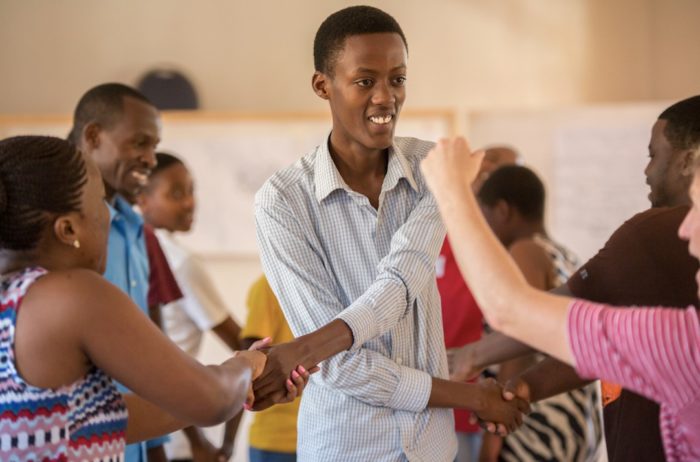
MAP Participants play Dr. Tangles, which is a good visual representation of a way a network plus project works. April, 2019. Photo: Deus Kwizera.
MAP was started as part of a Network Plus project called Changing the Story. This project was funded by a Global Challenges Research Fund grant from the Arts and Humanities Research Council lead by Dr. Paul Cooke from the University of Leeds. A Network Plus project works by first funding an initial pilot project, in our case Mobile Arts for Peace, working with researchers in both the UK and in Rwanda. Dr. Ananda Breed serves as the UK based Co-Investigator of the Rwanda Strand of this project. Hope Azeda served as the Rwanda based Phase One Co-Investigator while Dr. Eric Ndushabandi serves as the current Phase Two Co-Investigator. The goal of the pilot was to link together other researchers, artists and CSO’s working toward similar goals with an overarching theme of creating safe and inclusive participatory spaces for young people. We did this through working with Kwetu, Mashirika, Niyo, Future Vision Acrobats, Sana Initiative, REB, MindLeaps, Hope and Homes for Children, and other organisations that supported phase one activities including the training of teachers and creation of drama clubs.
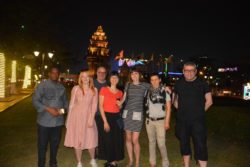
Dr. Eric Ndushabandi (left) joins other researchers and CTS project team including Dr. Paul Cooke (right) in Cambodia. March, 2019. Photo: Unknown.
The Network Plus project then supported new project ideas that were building off original phase one projects and findings, in our case Connecting Memories. Dr. Kirrily Pells, the UK based researcher, and Dr. Chaste Uwihoreye, the Rwanda based researcher, developed the project together from the work MAP accomplished in phase one. Their project was taking our initial findings and furthering the research, which connected MAP with new CSO’s and supported the work we hope to continue accomplishing. The major benefit so far of phase two has been to further expand on the role of psycho-social support and to help to integrate the work project partners are doing in to the original MAP structure.
MAP has been incredibly lucky to be partners with the Institute of Research for Dialogue and Peace for phase two. Eric Ndushabandi has approached MAP with such enthusiasm, and the project is helping to support initiatives within the organization steering future peace building projects to include psycho-social support. Representing Rwanda, Eric, Dr. Chaste Uwihoreye and Dr. Sylvestre Nzahabwanayo joined the Changing the Story team in Cambodia to learn more about CTS and share about MAP and their research.
During this time and separate from the original Changing the Story project structure, MAP was awarded three grants (two from the University of Lincoln and one from the Arts and Humanities Research Council) totaling £102,000 to continue the phase one goals and expand throughout the country of Rwanda. Dr. Ananda Breed serves as Principal Investigator of this follow up project which is titled “Ubwuzu: Shaping the Rwandan National Curriculum through the Arts”.

Dr. Eric Ndushabandi presents about Mobile Arts for Peace in Cambodia.
March, 2019. Photo: Unknown.
Changing the Story is going in to phase three to fund larger scale research projects that build off the work and continue the mission of these original two phases. The meeting in Cambodia was a time for all of these researchers to gather and share, meeting people who can help them achieve goals in their own countries and research. With each phase, new project partners are added creating a global network of people and organisations working toward common goals. Preparations are underway for a similar meeting to be held in Kigali, January 2020. More project information is available at https://changingthestory.leeds.ac.uk.
Mobile Arts for Peace is continuing to apply for grants and seeks project partners to continue the work of acomplished thus far. As we noted in our previous newsletter, MAP will be expanding to the other four provinces with a target to impact 300 adult trainers and 2,500 young people.
Transforming Trauma: Reimaging the Future through Arts in Rwanda and South Africa

Attendees of the colloquium gather in Kigali to share research and projects.
April, 2019. Photo: Emmanuel Tuyizere.

Dr. Eric Ndushabandi represents IRDP and Dr. Pumla Godobo-Madikizela represented Stellenbosch University at the signing of the partnership MOU. Photo: Emmanuel Tuyizere. April, 2019
A colloquium between the Institute of Research and Dialogue for Peace and the University of Stellenbosch was recently held at the IRDP Peace Center in the days leading up to Kwibuka 25. This colloquium reflected on the use of arts as a tool to heal trauma. Each country represented had its own history of trauma that could be explored. Speakers from South Africa reflected on remaining race divisions in artistic spaces while speakers from Rwanda shared initiatives such as MAP or Arts for Peace dialogues that have been used to create unity since the Genocide Against the Tutsi.
The colloquium included field visits to Bugesera to observe an IRDP community dialogue, to Rwamagana to observe a MAP club, a symposium in Kigali for researchers to share work, a publication from the University of Stellenbosch and an official partnership with IRDP for the continuation of work around these topics.

Mar 23, 2020 | Blog
This post was originally published via Changing the Story on 19th March 2020. Changing the Story is an AHRC GCRF project which asks how the arts, heritage and human rights education can support youth-centred approach to civil society building in post-conflict settings across the world. The development of the MAP project was a major output of Changing the Story and the two projects continue to work closely together. Find out more about Changing the Story and see the original post here: https://changingthestory.leeds.ac.uk
Written by Chaste Uwihoreye and Kirrily Pells, in collaboration with Eric Ndushabandi and Ananda Breed.
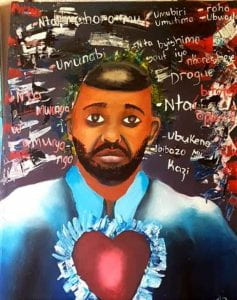
Credit: Chaste Uhiworeye
A common trope oft repeated in the wake of horrific events is that the ensuing pain is inexpressible or that certain stories cannot be told. In the case of Rwanda following the 1994 Genocide Against the Tutsi which saw between 800,000 and a million people killed in the space of 100 days, similar assumptions are also frequently deployed. One of us (Kirrily) recalls on her first visits to the country, being told mainly by other ‘outsiders’, but also by some Rwandans, that “Rwandans don’t talk”. However, as collaborator Chaste, a psychologist and Country Director of Uyisenga Ni Imanzi observes through his own work: Rwandans are talking all the time. Numerous Rwandan proverbs allude to the ways in which it is said that Rwandans may share information either briefly or even through silence and indeed it is those who do not understand what is being conveyed that say Rwandans do not talk. For example, “siko kumva, ubwira uwumva ntavunika” roughly translating as ‘to speak a lot does not make for more understanding’ or “ucira injiji amarenga amara ibinonko” meaning that you can use many gestures to talk with someone but if they are not aware of these gestures, you end up being tired. This instead challenges us as researchers and practitioners to better attend to the multiple ways in which people express their stories and crucially challenges us on how we might listen. Within our project Connective Memories: intergenerational expressions in contemporary Rwanda, on which we collaborate with Dr Eric Ndushabandi from the Institute of Research and Dialogue for Peace and Professor Ananda Breed from the University of Lincoln, we are working together with 10 young people and 6 adults as co-researchers on a participatory action research (PAR) project on the theme of isangizanyankuru. Isangizanyankuru was chosen by the group as a Kinyarwandan concept akin to memory but avoiding the more direct translation Kwibuka (meaning to remember) which is closely associated with the official commemoration of the Genocide. Participants noted that isangizanyankuru encompassed a sense of connection, between the individual and the collective and between past, present and future, with an emphasis on sharing through multiple modes of expression. Connective Memories works in collaboration with Mobile Arts for Arts to adapt arts-based methods to research.
One of the research questions for the project created by the co-researchers speaks to these concerns on listening to multiple forms of expression and asks ‘how do we respect the memories of others?’ In exploring this question, one emerging finding is the value and significance of proverbs both as a means of expressing one’s story and in listening to one another. In Rwanda, proverbs (imigani in Kinyarwanda) are “often used to express what a person has seen, heard and experienced at the level of emotions, feelings and states of mind, as well as to indicate to someone that they have been understood” (Bagilishya, 2000). As a Rwandan proverb states: “akari kumutima gasesekara ku munwa” meaning what you believe, think and feel has to be expressed externally by talking, actions, behaviours and attitudes. The Kinyarwanda word imigani therefore expresses the notion of a conversation or a dialogue, attempting to elicit “a mode of expression used to recognize, confirm and participate in what the other is living on an emotional level” (Bagilishya, 2000). In this sense, connectivity is at the heart of both isangizanyankuru and imigani so making the latter an interesting mode through which to explore the former. This approach really resonated with research participants. In an end of day reflective exercise where participants were asked which moment from the day they were going to take away with them, many repeated one of the proverbs that had been shared during the day and which had spoken to them.
Rwandan proverbs with their rich metaphorical language drawing on a rich repertoire of cultural symbolism therefore are an important mode of expression through which it is possible to express one’s own story or memories. During story circle, part of the Mobile Arts for Peace methodology, which the team drew upon for the Isangizanyankuru project, participants are asked to share a story which illustrated a conflict in the community which they would like to resolve. Participants’ memories and stories are often peppered with proverbs as a means of conveying multiple truths, such as “utaganiriye na se ntamenya icyosekuru yasize avuze” meaning when you do not talk with your father, you cannot know what your grandfather said before dying. This can be interpreted literally in the sense of regret at lack of family communication, but takes on particular significance in the Rwandan context and the often near absence of entire generations within families as a consequence of genocide. We have also used proverbs to help frame sessions focused on the sharing of memories and story. Proverbs such as “Ikinu kibi kibaho ni ukubwira utakumva” meaning something that is hurtful is to talk to someone who is not interested or “kubwira utakumva ni nko guta inyuma y’umusozi wa huye” meaning to speak to someone who is not interested is like the rain in Huye forest.
We have observed that proverbs facilitate a potentially transformatory encounter. Proverbs remind us that the person telling the story is the expert of their own life: “Ntiribara umukuru nk’umuto waribonye” (means that adults cannot explain better an event than the young person who has experienced it) is particularly pertinent for a project like Changing the Story, which aims to challenge adult-child power relations and foreground the stories of young people. The expression of a proverb after a story has been told, is a means of expressing an appropriate emotion, so honouring the person and the story – respecting the memories of others, to answer the question posed by the young people. This is important whether in the context of a research interview or therapeutic practice. As well as being an object of research therefore, we suggest that proverbs may be a way to research, as a mode of communication, as a way to build trust and empathy and as a means of exploring the multiple layers of experience: “Umugani Ugana Akariho” – the proverb reflects reality.
Mar 15, 2020 | Blog, Peace Education
This is a test post. We’ll update our blog page with more news and comment soon!

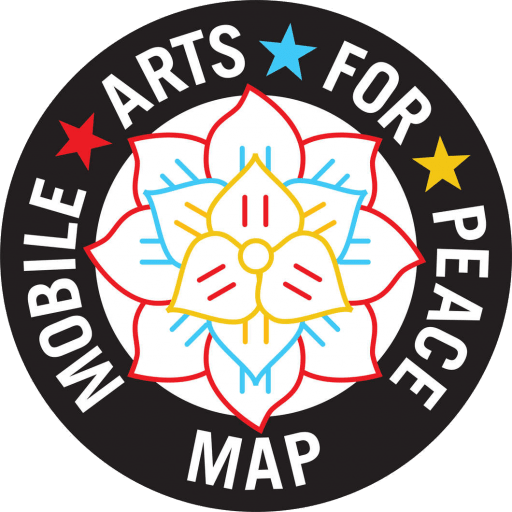

















 Hello, I am Samjhana Balami from Nepal, currently a management student and a freelancer. I am an introvert in nature but always ready to learn if get a chance. In the process of learning, some months ago, I got a chance to assist ‘
Hello, I am Samjhana Balami from Nepal, currently a management student and a freelancer. I am an introvert in nature but always ready to learn if get a chance. In the process of learning, some months ago, I got a chance to assist ‘

























Recent Comments